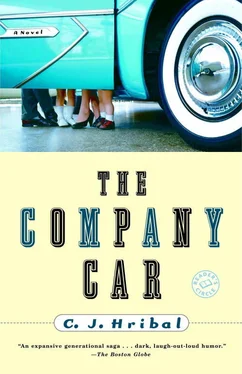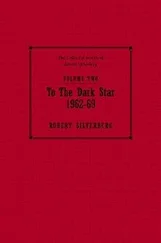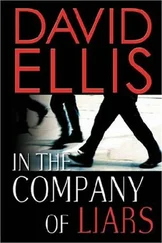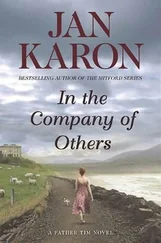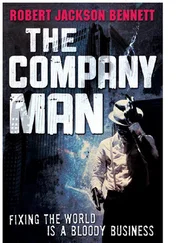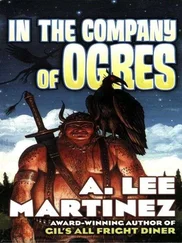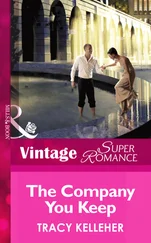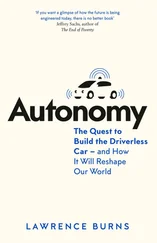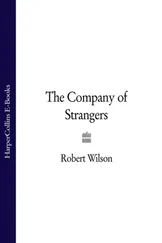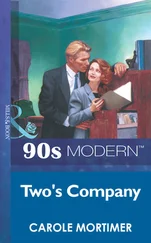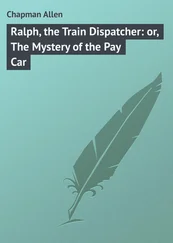Then peace comes, and our father, like a lot of people, is out of work. It’s hard to believe that six months after the war there might be a depression again, but there is. Littler this time, but still. Our father tries making a go of the band, but it’s pocket money now, not a regular thing, so he goes back to school, courtesy of the government, and meets our mother.
Dorie says, “I’ve always wondered about your mother.” She taps the photo of that woman on the tricycle, the woman in the black fitted velvet dress with the broad shoulders and the arresting cleavage. “How’d she come to be sitting there?” Dorie’s interest is usually tepid at best. She’s heard bits of our mother’s story before: How she was a sickly child, the oldest of what would have been eleven (a brace of miscarriages and eight stillbirths, the final two being twin boys). How she missed a grade and a half from scarlet and rheumatic fever and pneumonia, yet when she finally got to school she skipped another grade and a half. There are only a few surviving photos of our mother from those years, and in them she looks preternaturally old and tiny, like Shirley Temple. What Dorie wants, I think, are the insides of that life, something that only imagination can provide. I could tell her about our grandfather, how Arthur owned a restaurant, which he lost in the Depression, and then owned a shoe store and a candy store, both of which he lost as well, and how he ended up an elevator operator, and how all through this his wife, Naomi, was getting pregnant and losing children, and how, when he’d finally, through Christmas tips and careful investing, reacquired a nest egg, he was approached by the milk shake machine salesman Ray Kroc, an old friend, and was offered to be one of the initial investors in a fast-food enterprise, which he turned down because, after three businesses had gone belly-up on him, he was wary of ever doing that again to his family, especially since he’d have to borrow money for his share of the investment, and how that fast-food business eventually became McDonald’s, but that’s Arthur’s and Naomi’s story, not our mother’s.
But our mother herself? I glance again at that picture of her sitting on a trike in a velvet evening dress. It is 1949, and our mother is working as a secretary for seventy-five dollars a week, taking night courses at DePaul, then scattered throughout the Loop in rented brick office buildings. It is just after the war. A lot of G.I.s have come back from wherever, and they’re getting themselves educated on the G.I. Bill. They’ve learned to talk dirty and to get what they want by speaking plainly. Our mother, seventeen, sometimes dates these twenty-five-year-old ex-servicemen, which frightens the bejesus out of Naomi and Arthur. Their baby!
They need not have worried. Our mother expects to be treated like a lady no matter the age or needs of her prospective dates. Tired of the wolf whistles and the excited sniggering, she takes action against all of them one evening by coming to class armed with a book bag full of Hershey’s chocolate bars and nylons and Kools and Lucky cigarettes. She throws open the door and rains these items down on the servicemen’s heads. Then she announces, “There! You might have been able to buy a woman with that over in Italy or France or England or wherever you were, but it won’t work on me here. I already have plenty, thank you.” Then she storms off, cutting class, and forever after, she loved to report, they were courtly and polite and correct, and damn near protective of her coming and going. They gallantly open doors for her, offer to carry her books. They have become boys again, and handsome young men eager to please.
This is the woman I see perched on a tricycle in a form-fitting evening dress and a look in her eyes that would melt ice.
Our father, of course, was one of those boys, though, not having seen action, he was never so forward, and so never rebuked. The picture was taken on their first date. She is wearing black stockings and heels and black gloves, the kind you have to pull off with your teeth. Her dress is clinging to her thighs, she’s sitting on a tricycle, and the curve of her chest is amazing. That’s what always gets me—this sexy young woman posing on a child’s toy with a starred ball at her feet and some Buster Brown shoes running off the photo’s edge behind her. The incongruity of it all. She is young, curvaceous, sexy, beautiful. She seems destined for better things.
Better, maybe, than ending up with the man in the other photo, the man with the hat blowing away behind him, the man who took this picture of our mother. That’s probably what Dorie is thinking; I’ve thought it, too. Yet they married each other. I suppose that’s not so amazing, yet it seems so to me. I’ve known them only in their later incarnations. They no longer grin like idiots at their new albeit borrowed cars, and they wouldn’t think of hitching up a dress and posing on a tricycle. So how did they get that way? And when did they start leaving themselves behind? Did it happen when the photographs changed from black and white to color?
At the time of these pictures our father has been through one war and he’s about to be sent off to another, though he doesn’t know that yet. He is not quite twenty-three. He’s been through the Depression and a postwar recession. He wasn’t cut out for medical school, but then school was an afterthought; four nights a week he was singing and playing in a band. He had his buddies, his bandmates, and a bevy of young women he was dating, one of them our mother. Our mother, not yet twenty when she marries our father, spends the three years between that photo’s being taken and her engagement keeping sometimes as many as seven or eight dates a weekend with five or six different boys. To the Melrose Park harness track with one, to church with another, to the museum with a third, meeting a fourth at the zoo or Navy Pier, a movie or theater date later, coffee with somebody else later still, when she should have been studying (or perhaps it was a study date that became something else). She had an Italian boyfriend who was constantly telling her, “I will present you with many babies,” as though they would be gifts he’d go out and get her.
She thought she could love that guy but knew he wouldn’t respect her, and she didn’t like the idea of being barefoot and pregnant while he was off screwing other women. Our father said nothing about babies, he didn’t think he could be that lucky. He only promised he would love her. The babies would come later, fast and furiously, and every one of them, at the time anyway, seemed like a gift.
And then, of course, came all the rest of it, what they couldn’t see, what they couldn’t possibly know was coming.
Not that it mattered. Not that it mattered to anybody back then. Like most people at that time, our parents were young and scared and hopeful. They knew there were things out there that could touch them, could devastate them, but they also felt that they were the exception.
It turned out they were the rule.
But our parents didn’t know that. For some dates, especially after they got engaged—our father did the romantic thing, getting down on one knee in Grant Park while our mother sat on a bench, quivering with excitement—our parents took the bus out to Oak Park and walked around gawking at the stately old homes set back under the trees. They tried to imagine themselves inside these homes, but it was a stretch, a change in circumstance too large to contemplate. Mostly they took the trolley out to the intersection of Butterfield and York Road. The trolley shook something fierce, and our parents held hands, both for the touch and for the steadying influence of one hand linked with another. The trolley had a coal stove in the center of it to heat it in winter and it was a single line out and back and you had to wait in the cold for the next trip, which could take a while. But they would go out there, to York and Butterfield, and they would hold hands and dream. It was where they dreamed they’d live. It was mostly empty field and prairie, but in the stubble of cornfields powdered with snow they were putting up new houses. Skeletal wood-frame ranches and scaled-down foursquares with brick veneers. It looked lovely. It looked like obtainable possibility. It looked like the future.
Читать дальше
